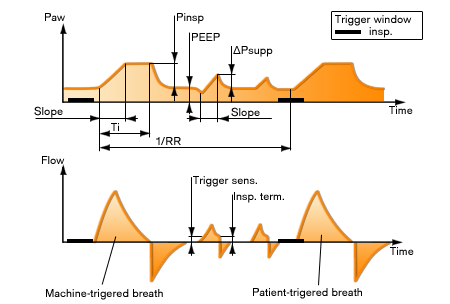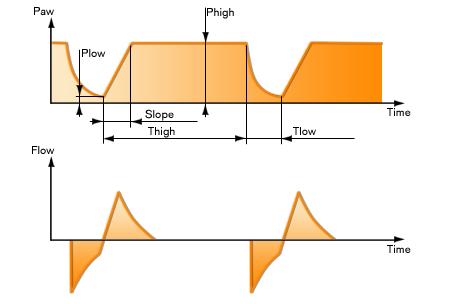- Device Gallery
- Device cockpit
- Mixer unit and status display
- Vapor 3000
- Vapor Mount
- Integrated Breathing System
- External fresh-gas outlet
- CO2 absorber
- Space for storage
- Working surface
- Trolley
- Hooks and brackets
- Anesthetic Gas Receiving System (AGRS)
- Mounting rails
- Column cover
- Cable channel
- Gas Inlet
- Interfaces
- Endotracheal Suction System
- Patient monitoring and IT
- Shelves
- Vapor 3000
- Ventilator (TurboVent 2)
- Ventilation Modes
- Device Monitoring
- Operating Concept
- Abbreviations
- Symbols
- Test
Pressure-controlled Ventilation
Pressure Control

Pressure Control - CMV
- Pressure-controlled.
- Time-controlled.
- Machine-triggered.
Mandatory breaths are machine-triggered and are not triggered by the patient.
Pressure Control - BIPAP
- Pressure-controlled.
- Time-controlled.
- Machine-triggered.
- Synchronized to inspiration.
In Pressure Control - BIPAP, the patient can breathe spontaneously at any time, while the number of mandatory breaths is preset. When synchronization is switched on, the breaths are adapted to the spontaneous breathing efforts of the patient.
Pressure Control - BIPAP / PS (optional)
This mode is similar to Pressure Control - BIPAP, except that the patient's spontaneous breathing at the PEEP level is pressure-supported with ΔPsupp when outside the trigger window.
Pressure Control - APRV (optional)

- Pressure-controlled.
- Time-controlled.
- Machine-triggered.
- Spontaneous breathing at continuous positive airway pressure with short pressure releases.
In Pressure Control - APRV, the patient's spontaneous breathing occurs at the upper pressure level Phigh. This pressure level is maintained for the duration Thigh. The number of pressure releases is determined by the Thigh and Tlow settings. The releases are time-controlled and are not triggered by the patient. The duration is determined by Tlow.
